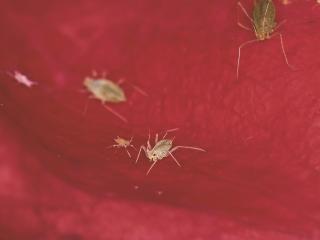Insect pests
Aphids
Aphids are sap-sucking insects that extract nutrients from the plant, particularly in spring. This activity can result in distorted leaves, drooping buds, stunted growth, and poor flowers. Aphids secrete honeydew, on which sooty mould may develop, further spoiling the plant’s appearance.
Small populations can be removed by hosing at high pressure, but this needs to be repeated every two or three days. If gardeners can wait two weeks without spraying any chemicals, beneficial insects like ladybirds and lacewings will build to sufficient numbers to prey on the aphids and reduce numbers. Spray big infestations with imidacloprid, acetamiprid, maldison, pyrethrins, or white oil. Chilli and/or garlic sprays are also effective and the garlic acts as a repellent to further aphid attack. This treatment will need to be repeated.
Thrips
Thrips are sap-sucking insects that can cause deformities in flowers, leaves, stems, and shoots. The insects are difficult to see because they are small and hide deep in the flower or on the undersides of the leaves, which become silvery on the upper surface. Thrips are most active during spring, summer and autumn.
To check for infestations tap flowers over a sheet of white paper and examine the black, torpedo-shaped 'specks' beneath a magnifying glass.
Small populations may not do enough damage to warrant chemical control. For large infestations, which can seriously weaken the plant, spray with imidacloprid, acetamiprid or pyrethrins. Horticultural soap is an organic control but it is often difficult to kill the pests when they are hidden deep within the flower petals.
Two-spotted mites
Mites are sap-sucking arachnids that can cause yellowing or bronzing of leaves. If the population is large, leaf drop occurs and the health of the plant is reduced. Two-spotted mite, also known as red spider mite, is the most serious pest mite. Although mites are so tiny that they are difficult to see, the fine webbing that they build across leaves and between leaves and stems betrays their presence. To reduce their numbers spray water beneath the rose leaves.
Being arachnids, mites are not susceptible to insecticides. Spray with lime sulphur or horticultural soap.
Scale insects
Scale are sap-sucking insects with a waxy or armoured cover which they use to protect themselves. Scales found on roses include cottony-cushion scale, red scale and rose scale and include ‘soft’ and ‘armoured’ varieties.
In soft scales, some scale insects hatch from eggs, while others are born live. Juvenile scales are known as crawlers. They disperse to favourable sites, settle down and start feeding. The juveniles then become sedentary, and start building their protective scale covers.
The females of most species remain under the covers for their entire life, while the male insects live under the covers until maturity, when they emerge as winged adults.
Scale is usually found on canes at the base of the plant but can cover higher stems. For minor infestations the scale insects can be rubbed off the rose canes using a damp cloth. Alternately smother the scale by spraying with a horticultural oil or spray with a potassium soap which works by blocking the breathing pores and disolving the scale's outer covering so it dehydrates and dies.

